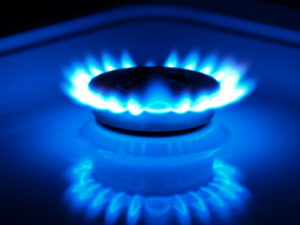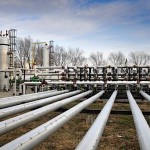 Natural gas kept most of its gains but eased off a recently hit 7-1/2-month high following EIAs report that showed US inventories fell below expectations last week. The energy source however remained supported as long-term weather forecasts continued to call for freezing cold temperatures across most of the densely-populated US areas.
Natural gas kept most of its gains but eased off a recently hit 7-1/2-month high following EIAs report that showed US inventories fell below expectations last week. The energy source however remained supported as long-term weather forecasts continued to call for freezing cold temperatures across most of the densely-populated US areas.
On the New York Mercantile Exchange, natural gas for delivery in January added 0.29% to trade at $4.350 per mBtu at 16:04 GMT. Prices swung between daily highs and lows of $4.431, the strongest level since May 1, and $4.335 per million British thermal units. The energy source marked a fifth consecutive day of gains, adding 6.9% for this week until now. The contract added 4.2% last week, after gaining 8.3% in the previous two 5-day-periods.
Gas retreated from a recently hit 7-1/2-month high after the Energy Information Administration reported that US gas inventories fell by 81 billion cubic feet in the week ended December 6, trailing expectations for an 85 billion decline according to the median estimate of 25 analysts surveyed by Bloomberg. The withdrawal was however well above last years 8 billion decline during the comparable period and also exceeded the five-year average drop of 76 billion cubic feet.
Total gas held in U.S. underground storage hubs equaled 3.533 trillion cubic feet as of Friday December 6th. Stockpiles were 273 billion cubic feet, or 7.2%, less compared to the same week a year ago and 109 billion cubic, or 3.0% feet less than the 5-year average of 3.642 trillion cubic feet. The deficit to the average amount widened to 3.0%.
Stockpiles in the East Region received a net withdrawal of 46 billion cubic feet to 1 815 billion and were 7.9% less than the average. In the West Region, stockpiles fell by 26 billion cubic feet to 504 billion and were 1.2% above the average. Meanwhile, inventories at the Producing Region fell by 9 billion cubic feet to 1 214 billion and exceeded the five-year average by 3.5%.
The fuel continued to draw support on outlook for freezing cold temperatures across most of the densely-populated US areas. NatGasWeather.com forecast a high pressure formation to expand into the central US, warming temperatures across much of the US today and on Friday. The only regions that will still experience below-normal temperatures this week and probably next week are the Great Lakes and Northeast. A strong winter storm will blast the Northeast this weekend, if two weather systems phase perfectly. Next week, the weather pattern will enter a transition period, with much warmer conditions pushing from west to east across the US, temporarily easing natural gas demand. Another major Arctic outbreak will cross the Northern Rockies around the 20th and will then push deep into the central and eastern US, with probability to significantly impact even the South. The cold blast will cause huge temperature anomalies, leading to massive surge in natural gas and heating demand. The forecast called for reinforcing shots of cold air, which will keep much of the nation in bitter cold temperatures through the Christmas Holiday and may be even to New Year.
NatGasWeather.com’s extended forecast for the week ending December 24th called for a transition period for the US, as a high pressure formation over the southern and central parts of the country will provide warmer temperatures. Parts of the Midwest and Northeast will still experience chilly conditions, while the south will warm considerably from 16th-19th. The next Arctic blast will probably push into the Northern Rockies around the 20th and will then rapidly push into the Plains and Midwest. The cold outbreak will bring temperature anomalies running well above 25-35 degrees Fahrenheit below normal. There is potential for the extreme cold to push deep into Texas and even the Southeast. There will also be areas of snowfall as the cold front blasts through the country. Huge natural gas draws are expected as much of the nation freezes under snow cover, low sun angle, and brutally cold temperatures.
According to AccuWeather.com, the low in Indianapolis on December 18th will be 6 degrees Fahrenheit, or 18 degrees beneath average. Readings in Detroit on December 18th will bottom at 13 degrees Fahrenheit, below the average of 24 degrees, while the low in Chicago will be 5 degrees Fahrenheit, 17 degrees beneath normal.
When cold weather is expected, natural gas surges as increased electricity demand to power air-conditioning calls for more supply of the fuel, which is used for a quarter of U.S. electricity generation. Above-average readings in the winter season have the opposite effect. Consumption usually picks up from November through March. According to the Energy Information Administration, power generation accounts for 32% of U.S. gas demand and 49% of U.S. households use the energy source for heating.





